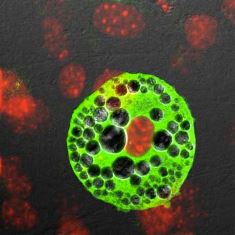New type of fat cell discovered
8 May 2013
A new type of brown fat cell has been discovered in human infants by researchers at Sahlgrenska Academy in Sweden. The researchers call the new type of brown fat tissue "classical brown fat".
The tissue was discovered using high-resolution imaging techniques and histological and biochemical analyses. It was previously only known to be present in small mammals. Unlike white fat cells, which store the body's surplus energy, brown fat cells have the unique property of being able to turn fat it into body heat and is essential for the survival of small mammals in a cold environment. In humans it seems to disappear during adolescence.
"We already know that those of us who have more brown fat tissue have a smaller risk of developing type 2 diabetes. With these new results, we should eventually be able to develop methods for stimulating the brown fat tissue, so that some of the surplus energy we store in the form of fat tissue can be converted into heat.
"Such a treatment could both prevent obesity and reduce the risk of developing obesity-related diseases such as type 2 diabetes," said Sven Enerbäck who heads the country's leading research group in the study of fat cells and metabolism.

The newly discovered brown fat cell.
Credit: The University of Gothenburg
The discovery opens up new opportunities for future medicines that exploit the brown fat cells' ability to consume calories. "One idea is to be able to "reactivate" the classical brown fat tissue in older people and so treat obesity," said Enerbäck.
Reference
Evidence for two types of brown adipose tissue in humans. Published online in Nature Medicine on 21 April 2013.